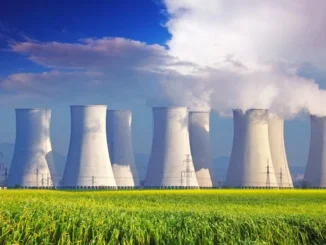
Let’s say a hundred years ago some rattled soul emigrated from Russia to this country, fleeing, I don’t know, the Russian revolution or in-laws, whatever. Let’s say he/she became a wealthy industrialist and built a bunch of stuff, and among the accomplishments was the construction of a major airport that became a massive central link in a global distribution hub (hey, it’s just a thought exercise, no judging). The hub grew to include warehouses and trucking operations and you name it, and wealth spread across the land because of this monolith.
Then let’s say a new type of cargo jet arrives on the scene, one so huge that it can’t land on that airport’s runway. The cargo jet rapidly becomes dominant in the world, and the huge airport hub in question will be rendered useless unless the runway can be extended by the length of a football field, and there is plenty of room. If it isn’t extended, cargo traffic will begin rerouting to different hubs that handle the traffic, and the entire structure will fall into disuse and fill with squatters and rats and the next generation of punk rockers.
What would you think if the region’s government elected to scrap the entire transport/distribution complex and build a new one instead of expanding the runway, just because the original constructor was Russian, and Russia under Putin is now trying to live out some fifteenth-century vision of ape-like glory (and failing spectacularly – Ukraine standing up to such a bully is going to be legendary).
That’s essentially what is happening in the energy world. Decarbonization efforts are everywhere (the International Energy Agency says that currently more than half of total energy jobs worldwide are in “clean energy” – a staggering statistic and a sock in the mouth of everyone saying “we’re not doing enough”). Even in the heart of the oil patch, few if any are opposed to environmental progress, though the reasons for pursuing policy “in the name of the environment” are by no means homogeneous (some value habitat conservation above all, some CO2 emissions, some air pollution, etc.).29dk2902lhttps://boereport.com/29dk2902l.html
But decarbonization is, as should now be obvious, unbelievably difficult. It is starting to dawn on everyone (save the few climate warriors hiding in trees who don’t realize yet that the war is over) that demolishing the world’s hydrocarbon based system and replacing it with something else entirely is a pipe dream, for the next half century anyway. The iron-clad laws of industrial development simply won’t allow a rapid energy transition based on dismantling hydrocarbon supply; it takes forever to build anything, and at the first sign of voter stress, politicians turtle, subsidize energy bills, and quietly fire up the coal plants. Yet those clinging to the renewable-dominant dream do so with a vengeance, and for that we will pay – either through an incredibly diminished standard of living, or eventually through our tax bill. Someone has to pay for everything.
And since someone has to pay for everything, it is imperative that we spend every dollar wisely.
Consider hydrogen, for example. Hydrogen, despite many problems, is becoming a dominant topic in current energy discussions as a fuel of the future. (In the 2019 classic The End of Fossil Fuel Insanity, widely regarded as one of the top three energy books ever by an author hailing from Sub-Division 7 of the North East Saskatchewan School Division, the author deftly delivers an unimpeachable summation of the value of hydrogen as a transition fuel.) Hydrogen is a clean burning fuel, and when used as fuel in fuel cells, has only water as an output.
There are various ways to create hydrogen as a fuel, with the source now being annoyingly colour-coded in an effort to make sure that some methods are considered morally superior to others (certainly not economically). Green hydrogen is viewed as the climatic gold standard, being made from renewable energy. Any other colour implies descending levels of respect among policymakers, depending on the presence of hydrocarbons in the supply chain and/or the emissions related therein.
Green hydrogen as a widespread fuel source would be pretty cool, and also a good use for the endless acres of windmills and solar panels being thrown up that will marginally reduce emissions, massively disrupt local ecosystems, and flummox grid operators endlessly with their intermittency and unreliability. But to become a significant component of global energy consumption, the cost will be astronomical (green hydrogen is hideously expensive compared to other sources when the all-in infrastructure costs are included, not to mention the challenge of finding enough water).
One would think and hope that policymakers would, if so enamoured of hydrogen, find ways to utilize the existing infrastructure in any way possible first and foremost, because even in the tar pits of bureaucracy it must be known that building new infrastructure of any stripe is beyond challenging.
There are ways, or at least ways that show great potential, to generate hydrogen cleanly and on a massive scale that should be foremost in any government’s mind before pursuing multi-billion dollar thought exercises that “look good on paper”. Consider methane pyrolysis, a process by which natural gas (from the existing ubiquitous system) is heated in a reactor in a way that decomposes the gas into hydrogen and “carbon black”, a substance used in plastics, ink, and rubber products, according to this University of Alberta article.
Carbon black can also be configured (bad word, I know, process engineers, don’t shoot me) into other high-value carbon based materials like carbon nanotubes or carbon fibre or graphene (I know very little about any of these except that carbon fibre looks really expensive, is incredibly strong (pioneered in Fomula 1 car chassis’), and looks really cool as a stupidly priced option in your average Ferrari).
The beauty of methane pyrolysis is that it utilizes to a great degree the trillions of dollars worth of infrastructure and knowledge that has already been developed and time-tested and works incredibly well. Consider the challenges of distributing a gas through a pipeline system, all the way from massive 36-inch mainline pipes (or bigger) right down to tiny low pressure lines that provide heat, cooking, and clothes drying services (about half the homes in the US rely on natural gas).
Think of the cost of implementing that system, and the cost of duplicating it with something else. In addition to residential usage, this same natural gas system fuels much of the world’s industrial processes including fertilizer production and processing of many critical metals/materials. Abandoning the natural gas system in pursuit of something else is madness, if there is any alternative at all. And there is.
There are hundreds of thousands of miles of natural gas pipe in the ground, globally. We have vast resources of natural gas around the world. We have a highly-skilled workforce that is incredibly good at finding and producing natural gas. The investment and knowledge base is unbelievably large. And yet governments are willing to look at that whole enchilada and say, “meh, I’d rather throw that all in the dumpster and build something else from scratch. In ten years.” Or 3 years, as Trudeau promised Germany a supply of green hydrogen by, an idea that still is wandering the halls of every active/energy-conscious brain, trying to find a welcome. So far, it wanders alone.
The technology behind methane pyrolysis is well proven, and the processes involved are well understood (current research is focused on making the process more efficient). Hydrogen can be produced without the construction of wind farms, solar fields and/or the development of carbon capture/sequestration schemes necessary to de-carbonize traditional hydrogen-generating processes.
According to the same U of A article, hydrogen could deliver up to 30 per cent of Canada’s end-use energy and up to 24 per cent of global energy demand by 2050. If we rely on schemes like green hydrogen from wind/solar, those numbers will most likely remain in the realm of wishful thinking. If we could develop something like methane pyrolysis, the goal might be within reach – primarily because we don’t have to reconstruct an entire new energy system. Methane pyrolysis won’t work everywhere on earth; it may be limited to areas with extensive natural gas development/infrastructure.
Another potential drawback, as one of the genius engineers in the field pointed out to me is that, if the technology became widespread, enormous volumes of carbon would be generated which could swamp the market. However, a dirt-cheap source of such a versatile raw material might develop a whole range of new options for its commercial use. It would be an exciting and interesting prospect to have to deal with. And the world is pretty well covered with natural gas infrastructure, so we will all be very old people before all those potential development sites are exhausted.
Canada is incredibly active in hydrogen development, including in the very heart of the oil patch that is supposedly not interested in new energy ideas (it is, very much so, the patch just wants to address the topic intelligently and capital-efficiently).
The so-called ‘turquoise hydrogen’ field includes many companies such as Innova Hydrogen, Aurora Hydrogen, Ekona Power, Monolith Corp. (out of Nebraska), New Canadian Energy, and others who may feel free to remind me that I missed them. Some of these entities have begun production, including Monolith, which has also signed a letter of intent and collaboration agreement with Goodyear for use of carbon black in tire production.
This is very exciting stuff. It’s real, the technology works, and it could be a massive boost towards emissions reduction – and it might create a whole new industry. Or industries.
Hydrogen via methane pyrolysis is the sort of capital-efficient new-energy dream scenario that governments should be most interested in.
Recent studies indicate some people have not bought this book yet. That might explain a lot of the chaos. Pick up “The End of Fossil Fuel Insanity” at Amazon.ca, Indigo.ca, or Amazon.com. It’s not too late. Thanks for the support. And hang in there Ukraine! The world is cheering you on.
Read more insightful analysis from Terry Etam here, or email Terry here.



